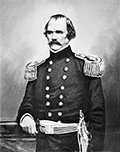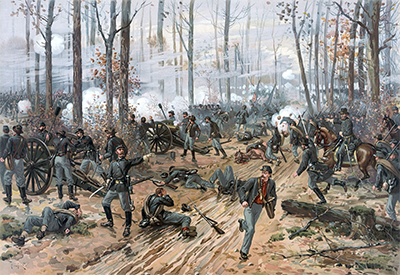Confederate General Albert Sidney Johnston
Albert Sidney Johnston was a Confederate general during the American Civil War. Wounded on the battlefield early in the war, he was the highest-ranking commander to die on either side. 
He was born in Washington, Ky., on Feb. 2, 1803. He went to Transylvania University and entered the U.S. Military Academy. Graduating in 1826 as a second lieutenant, he served in the Black Hawk War. He married Henrietta Preston in 1829; they had two children. When she became gravely ill, in 1834, he left the Army to care for her. She died in 1836. He fought on behalf of the Texians during the struggle for Texas independence and then served as Secretary of War of the Republic of Texas in 1838–1840. In 1843, he married Eliza Griffin; they reared his two children and had three of their own. Serving under Zachary Taylor, he commanded a volunteer regiment during the Mexican-American War and saw action at Monterrey, for which he was cited for bravery, and at Buena Vista. All of his actions in Texas were not connected with the U.S. Army, from which he had resigned in 1834. He re-enlisted in 1849, served as paymaster and then promoted to colonel in the 2nd U.S. Cavalry, seeing actions against Comanche in the West. He headed up the Department of Texas in 1856–1858 and then the Department of Utah until 1860. In between, he led troops into Utah in a confrontation with the Mormon leader Brigham Young that ended with the installation of a new governor in the Utah Territory. The Mormon War, as it became known, involved thousands of troops and resulted in some acts of violence, but no deaths occurred and the conflict ended with a diplomatic solution. Johnston then served for a few months as commander of the Department of the Pacific.  Johnston, though opposed to secession, resigned from the U.S. Army when Texas seceded from the Union and offered his services to the Confederate army. He served as commander of Western forces. His wartime career was brief. Tasked initially with defending large swathes of land with slight numbers of troops, he eventually abandoned Kentucky and most of Tennessee and decided to concentrate his forces with Gen. P.G.T. Beauregard at Corinth, Miss. Johnston fought in the Battle of Shiloh and died from a wounded suffered on that battlefield, having ridden too far ahead on his troops and been shot in the leg. Compounding his injury was an earlier wound, suffered in a duel with a fellow officer, that had deadened his nerve endings; Johnston, having sustained the wound, fought on, leading from the front and urging his inexperienced troops to charge the enemy. He bled to death on the battlefield, in April 6, 1862; he was 59. |
|
Social Studies for Kids
copyright 2002–2025
David White




